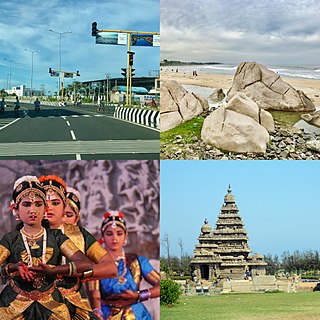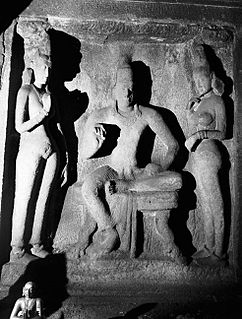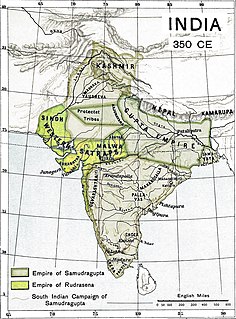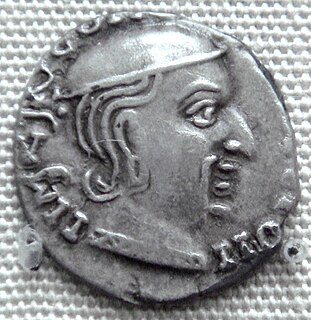Related Research Articles
The Kali Yuga, in Hinduism, is the fourth and worst of the four yugas in a Yuga Cycle, preceded by Dvapara Yuga and followed by the next cycle's Krita (Satya) Yuga. It is believed to be the present age, which is full of conflict and sin.

The Middle kingdoms of India were the political entities in India from 200 BC to 1200 AD. The period begins after the decline of the Maurya Empire and the corresponding rise of the Satavahana dynasty, starting with Simuka, from 230 BC. The "Middle" period lasted for about 1,500 years and ended in 1200 AD, with the rise of the Delhi Sultanate, founded in 1206, and the end of the Later Cholas.

Mahabalipuram, also known as Mamallapuram, is a town in Chengalpattu district in the southeastern Indian state of Tamil Nadu, best known for the UNESCO World Heritage Site of 7th- and 8th-century Hindu Group of Monuments at Mahabalipuram. It is one of the famous tourist sites in India.

Indo-Scythians were a group of nomadic Iranian peoples of Saka and Scythian origin who migrated from Central Asia southward into northern and western South Asia from the middle of the 2nd century BCE to the 4th century CE.

The Pallava dynasty was an Indian dynasty that existed from 275 CE to 897 CE, ruling a portion of southern India. They gained prominence after the eclipse of the Satavahana dynasty, whom the Pallavas served as feudatories.

Simhavishnu, also known as Avanisimha, son of Simhavarman III and one of the Pallava kings of India, was responsible for the revival of the Pallavan dynasty. He was the first Pallava monarch whose domain extended beyond Kanchipuram (Kanchi) in the South. He was portrayed as a great conqueror in Mattavilasa Prahasana, a drama written by his son Mahendravarman I.

The Kawi script (Indonesian: Aksara Kawi, or Old Javanese script, is a Brahmic script found primarily in Java and used across much of Maritime Southeast Asia between the 8th century and the 16th century. The script is an abugida meaning that characters are read with an inherent vowel. Diacritics are used, either to suppress the vowel and represent a pure consonant, or to represent other vowels.

Narasimhavarman I or Narasimha Varma I was a emperor of the Pallava dynasty who ruled South India from 630–668 AD. He shared his father Mahendravarman I's love of art and completed the work started by Mahendravarman in Mamallapuram. During his reign famous Pancha Rathas Temple was constructed which is Rock Cut Temple, a UNESCO World Heritage site.
Vikram Samvat or Bikram Sambat and also known as the Vikrami calendar, is the historical Hindu calendar used in the Indian subcontinent. It is the official calendar of Nepal. In India it is used in several states. The traditional Vikram Samvat calendar, as used in India, uses lunar months and solar sidereal years. The Nepali Bikram Sambat introduced in 1901 AD, uses a solar tropical year.

The Western Satraps, or Western Kshatrapas were Indo-Scythian (Saka) rulers of ancient India who ruled over the region of Sindh, Makran, Saurashtra and Malwa, between 35 to 405 CE. The Western Satraps were contemporaneous with the Kushans who ruled the northern part of the Indian subcontinent, and were possibly vassals of the Kushans. They were also contemporaneous with the Satavahana (Andhra) who ruled in Central India. They are called "Western Satraps" in modern historiography in order to differentiate them from the "Northern Satraps", who ruled in Punjab and Mathura until the 2nd century CE.
Pulakeshin II was the most famous ruler of the Chalukya dynasty of Vatapi. During his reign, the Chalukya kingdom expanded to cover most of the Deccan region in peninsular India.
Dravida is mentioned as one of the kingdoms in the southern part of present-day mainland India during the time of the Mahabharata.

The Vishnukundina dynasty was an Indian imperial power controlling the Deccan, Andhra Pradesh, Telangana, Odisha and parts of South India during the 5th and 6th centuries, carving land out from the Vakataka Empire. It played an important role in the history of the Deccan during the 5th and 6th centuries. The dynasty initially ruled from Indrapalanagara, and later shifted to Denduluru, and Amaravathi.

Parigi is a city Anantapur district in the state of Andhra Pradesh in India.

The legacy of the Indo-Greeks starts with the formal end of the Indo-Greek Kingdom from the 1st century, as the Greek communities of central Asia and northwestern India lived under the control of the Kushan branch of the Yuezhi, apart from a short-lived invasion of the Indo-Parthian Kingdom. The Kushans founded the Kushan Empire, which was to prosper for several centuries. In the south, the Greeks were under the rule of the Western Kshatrapas.

Jivadaman was a Saka ruler of the Western Kshatrapas in northwestern India from during the 2nd century CE. He was the son of Damajadasri I (170–175), and the brother of Satyadaman.
Simhavarman III was a ruler of the Pallava dynasty who reigned in the first half of the 6th century AD. He is the father and predecessor of Simhavishnu. He is the donor of Pallan Kovil Jaina Copper Plates, which is dated in his 6th regnal year.
Varman or its variants, Varma, Verma, Varman, Burman or Barman, are surnames that are used in India & South-East Asia.
The Flag of Pallava was used by the Tamil Pallava Kingdom. The Pallava royal insignia was the Simha (Lion) and Nandi (Bull) which was changeable. But Color of flags saffron or yellow. Each Pallava king had his own personal banner. Example, Narasimhavarman II used the lion as his emblem and Nandivarman II preferred the Nandi. Under the reign of Paramesvaravarman I was Khatvanga added to Pallava emblem. There were probably different Pallava lines, The main line ruled in Kanchipuram and comes from the Simha line. The Simha emblem were inherited from descendants of the Simha line.
References
- ↑ Vincent A. Smith (1906). Volume 2 – From the Sixth Century B.C. to the Mohammedan Conquest, Including the Invasion of Alexander the Great. p. 383. Retrieved 6 November 2012.